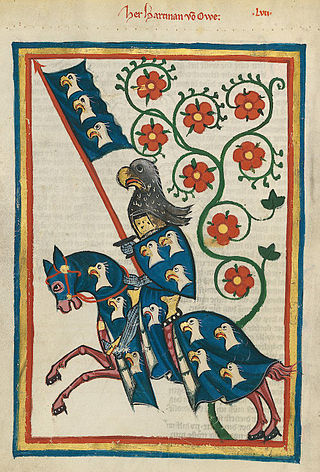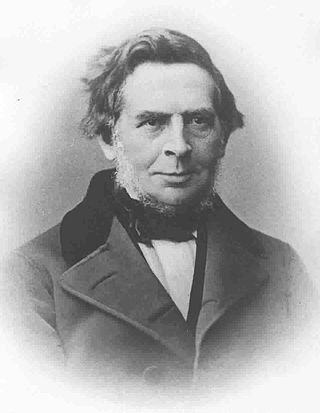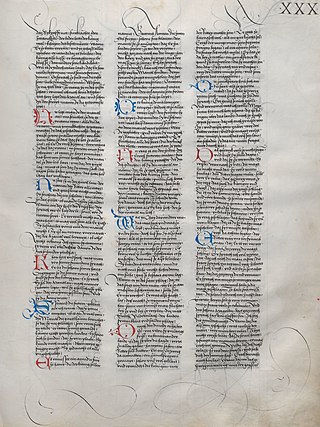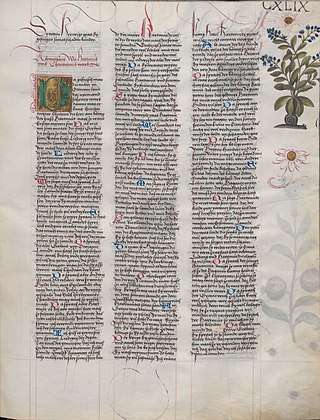
The Nibelungenlied, translated as The Song of the Nibelungs, is an epic poem written around 1200 in Middle High German. Its anonymous poet was likely from the region of Passau. The Nibelungenlied is based on an oral tradition of Germanic heroic legend that has some of its origin in historic events and individuals of the 5th and 6th centuries and that spread throughout almost all of Germanic-speaking Europe. Scandinavian parallels to the German poem are found especially in the heroic lays of the Poetic Edda and in the Völsunga saga.

Moriz or Moritz Haupt, was a German philologist.

Hartmann von Aue, also known as Hartmann von Ouwe, was a German knight and poet. With his works including Erec, Iwein, Gregorius, and Der arme Heinrich, he introduced the Arthurian romance into German literature and, with Wolfram von Eschenbach and Gottfried von Strassburg, was one of the three great epic poets of Middle High German literature.

Karl Joseph Simrock was a German poet and writer. He is primarily known for his translation of Das Nibelungenlied into modern German.
Middle High German is the term for the form of German spoken in the High Middle Ages. It is conventionally dated between 1050 and 1350, developing from Old High German and into Early New High German. High German is defined as those varieties of German which were affected by the Second Sound Shift; the Middle Low German and Middle Dutch languages spoken to the North and North West, which did not participate in this sound change, are not part of MHG.

Gottfried von Strassburg is the author of the Middle High German courtly romance Tristan, an adaptation of the 12th-century Tristan and Iseult legend. Gottfried's work is regarded, alongside the Nibelungenlied and Wolfram von Eschenbach's Parzival, as one of the great narrative masterpieces of the German Middle Ages. He is probably also the composer of a small number of surviving lyrics. His work became a source of inspiration for Richard Wagner's opera Tristan und Isolde (1865).
Yvain, the Knight of the Lion is an Arthurian romance by French poet Chrétien de Troyes. It was written c. 1180 simultaneously with Lancelot, the Knight of the Cart, and includes several references to the narrative of that poem. It is a story of knight-errantry, in which the protagonist Yvain is first rejected by his lady for breaking a very important promise, and subsequently performs a number of heroic deeds in order to regain her favour. The poem has been adapted into several other medieval works, including Iwein and Owain, or the Lady of the Fountain.
Erec and Enide is the first of Chrétien de Troyes' five romance poems, completed around 1170. It is one of three completed works by the author. Erec and Enide tells the story of the marriage of the titular characters, as well as the journey they go on to restore Erec's reputation as a knight after he remains inactive for too long. Consisting of about 7000 lines of Old French, the poem is one of the earliest known Arthurian romances in any language, predated only by the Welsh prose narrative Culhwch and Olwen.

Lanzelet is a medieval romance written by Ulrich von Zatzikhoven after 1194. It is the first treatment of the Lancelot tradition in German, and contains the earliest known account of the hero's childhood with the Lady of the Lake-like figure in any language. The poem consists of about 9,400 lines arranged in 4-stressed Middle High German couplets. It survives complete in two manuscripts and in fragmentary form in three others.

Gregorius or The Good Sinner is a Middle High German narrative poem by Hartmann von Aue. Written around 1190 in rhyming couplets, it tells the story of a child born of the incestuous union of a brother and sister, who is brought up in a monastery, ignorant of his origins, marries his mother, repents of his sins and becomes pope.

Iwein is a Middle High German verse romance by the poet Hartmann von Aue, written around 1200. An Arthurian tale freely adapted from Chrétien de Troyes' Old French Yvain, the Knight of the Lion, it tells the story of Iwein (Yvain), a knight of King Arthur's Round Table. It was written after Hartmann's Erec, and is generally taken to be his last work.
Amis and Amiloun is a Middle English romance in tail rhyme from the late thirteenth century. The 2508-line poem tells the story of two friends, one of whom is punished by God with leprosy for engaging in a trial by ordeal after the other has been seduced and betrayed. The poem is praised for the technical competency displayed in the stanzaic organization, though its quality as a chivalric romance has been debated. It is found in four manuscripts ranging from c. 1330 to c. 1500, including the Auchinleck Manuscript.
Middle High German literature refers to literature written in German between the middle of the 11th century and the middle of the 14th. In the second half of the 12th century, there was a sudden intensification of activity, leading to a 60-year "golden age" of medieval German literature referred to as the mittelhochdeutsche Blütezeit. This was the period of the blossoming of Minnesang, MHG lyric poetry, initially influenced by the French and Provençal tradition of courtly love song. The same sixty years saw the composition of the most important courtly romances. again drawing on French models such as Chrétien de Troyes, many of them relating Arthurian material. The third literary movement of these years was a new revamping of the heroic tradition, in which the ancient Germanic oral tradition can still be discerned, but tamed and Christianized and adapted for the court.

Erec is a Middle High German poem written in rhyming couplets by Hartmann von Aue. It is thought to be the earliest of Hartmann's narrative works and dates from around 1185. An adaptation of Chrétien de Troyes' Erec et Enide, it is the first Arthurian Romance in German.

Der Busant, also known as Der Bussard, is a Middle High German verse narrative, containing 1074 lines of rhyming couplets. The story tells of a love affair between the Princess of France and the Prince of England, who elope but are separated after a buzzard steals one of the princess's rings. After more than a year of separation, with the prince having gone mad and living as a wild man, they are reunited.

The Ambraser Heldenbuch is a 16th-century manuscript written in Early New High German, now held in the Austrian National Library. It contains a collection of 25 Middle High German courtly and heroic narratives along with some shorter works, all dating from the 12th and 13th centuries. For many of the texts it is the sole surviving source, which makes the manuscript highly significant for the history of German literature. The manuscript also attests to an enduring taste for the poetry of the MHG classical period among the upper classes.
Guiomar is the best known name of a character appearing in many medieval texts relating to the Arthurian legend, often in relationship with Morgan le Fay or a similar fairy queen type character.

Cyril William Edwards was a British medievalist and translator. Teaching in London and Oxford, he published extensively on the medieval German lyric and Old High German literature, and translated four of the major Middle High German verse narratives.
In the Middle High German (MHG) period (1050–1350) the courtly romance, written in rhyming couplets, was the dominant narrative genre in the literature of the noble courts, and the romances of Hartmann von Aue, Gottfried von Strassburg and Wolfram von Eschenbach, written c. 1185 – c. 1210, are recognized as classics.
Der arme Heinrich is a German-language opera in three acts by Hans Pfitzner to a libretto by James Grun. The premiere was at the Mainz Municipal Theatre on 2 April 1895.













